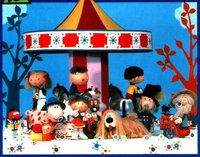The Magic Roundabout
|
|
Le Manège Enchanté (known in English as The Magic Roundabout) was a children's television programme created in France in 1963 by Serge Danot. Around 500 5-minute-long episodes were made and were originally broadcast from 1964 until 1971 on ORTF.
It is best known in the United Kingdom, where it was shown with an English narration, by Eric Thompson, from 18 October 1965 to January 1977. The English-language version show attained cult status and was watched as much by adults for its dry humour as by the children for which it was intended.
The characters were given different names in the different languages. The main character was Dougal or Pollux, (a dog - in the French version he had a comical English accent). Other characters are Zebedee or Zébulon, a jack-in-the-box, Brian or Ambroise (a snail), Ermintrude or Azalée (a cow), Dylan or Flappy (a rabbit, in the French version, Spanish). There are two notable human characters - Florence or Margotte, a young girl, and Mr Rusty or le Père Pivoine, the operator of the roundabout.
The show had a distinctive visual style. The set was a brightly coloured and stylized park containing the eponymous roundabout (a fairground carousel). The programmes were created by stop frame animation, which meant that Dougal was made without legs as it was felt that with legs he would be too difficult to animate, Zebedee was created from a giant pea which was available in the animation studio and was re-painted. The look of these characters was the responsibility of British animator Ivor Wood, who was working at Danot's studio at the time (and would later go on to animate The Herbs, Paddington Bear and Postman Pat).
| Contents |
English version
The English (BBC) version was especially distinct from the French version in that the narration was entirely new, created by Eric Thompson from just the visuals and not based on the script by Serge Danot that accompanied the original animations.
The first BBC broadcasts were stripped across the week (shown at 1755, just before the Six O'Clock News each day), which was the first time an entertainment programme had been transmitted in this way in the UK. Since BBC1 did not start broadcasting in colour until November 1969, the series was seen only in black and white in the UK until then.
52 additional episodes, not previously translated, were shown in the UK during 1992 by Channel 4. Since by that time Thompson was no longer alive the job of narrating them in a pastiche of Thompson's style went to Nigel Planer.
The English Dougal was grumpy and loosely based on Tony Hancock. Ermintrude was rather matronly and fond of singing. Dylan was a hippy-like rabbit, rather dozey. Florence was portrayed sensibly. Brian was unsophisticated but well-meaning. Zebedee is an almost human creature in a soldier's uniform with a spring instead of feet; he frequently went "Boing!" and regularly closed the show with the phrase "Time for bed." In the original French pilot he was seen emerging from a jack-in-the-box, which explains the spring.)
Other characters include Mr MacHenry, Mr Rusty and the train.
Part of the show's attraction was that it appealed to adults, who enjoyed the world-weary Hancock-style comments made by Dougal, as well as to children. The audience was measured at eight million viewers at its peak.
There is speculation about possible interpretations of the show. One theory is that the characters represented French politicians of the time (Dougal being De Gaulle for instance). Another is that each character was addicted to a different type of psychotropic drug as Dylan was named for Bob Dylan. Neither theory is likely to be true. The second theory was denied by Eric Thompson's widow, Phyllida Law.
Theme tunes
Both the French and the English versions had distinctive theme tunes. The French tune was organ and child-adult vocals. The English version, by Alain Legrand, removed the vocals and increased the tempo of the tune while making it sound as if it was played on a fairground organ (it can be found here (http://tv.cream.org/specialassignments/themes/magicroundabout.mp3)).
Film versions
Danot made a longer film, Pollux Et Le Chat Bleu, in 1972 which was also adapted by Thompson and shown in Britain as Dougal and the Blue Cat. The cat, named Buxton, was working for the Blue Voice who wanted to take over the garden. The Blue Voice was voiced by Fenella Fielding and was the only time that Eric Thompson called in another person to voice a character.
A new film version was released in 2005, with both languages using the French style of each character having its own "voice". Voice artists are:
Magic_Roundabout_New.JPG
| English character | English actor | French character | French actor |
|---|---|---|---|
| Florence | Kylie Minogue | Margote | Vanessa Paradis |
| Ermintrude | Joanna Lumley | Azalée | Valérie Lemercier |
| Dougal | Robbie Williams | Pollux | Henri Salvador |
| Brian | Jim Broadbent | Ambroise | Dany Boon |
| Dylan | Bill Nighy | Flappy | Eddy Mitchell |
| Zebedee | Sir Ian McKellen | Zébulon | Elie Semoun |
| ZeBad | Tom Baker | Zeebad | Michel Galabru |
Musical spinoffs
In 1975 Jasper Carrott recorded a short, risqué comic monologue, parodying The Magic Roundabout, which was released on a single as the B-side of his comic song "Funky Moped". The record was a hit, but Carrott always claimed people were buying it for the B-side and not for the song, which he soon came to hate. The show's theme music also featured on two minor UK hit singles in 1991, "Summer's Magic" by Mark Summers and "Magic Style" by The Badman.fr:Le Manège enchanté

